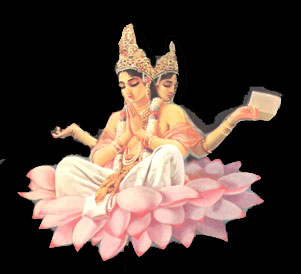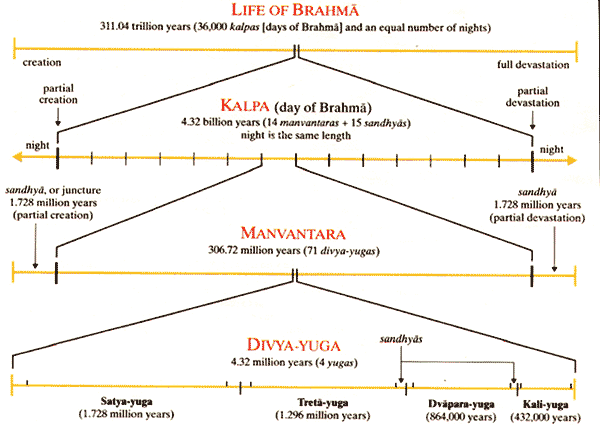|
All in A Day
of Brahma
What does Krishna mean by the beginning
of creation? According to the Puranas (Vedic histories), there have
been innumerable creations in the course of cyclical time. The basic
unit of Vedic cyclical time is the day of Brahma, which lasts
4.32
billion years. The day of Brahma (also called a kalpa) is followed
by a night of Brahma, also lasting 4.32 billion years.
The cycle of
days and nights of Brahma toes on for Brahma's lifetime of one
hundred years (36,000 nights), equivalent to 311.04 trillion of our
human years. During the day of Brahma, life, including human life,
is manifest. During the night of Brahma, life is not manifest.

A
Vedic Conception of Time
"Outside of the three planetary
systems, the four Yugas multiplied by one
thousand comprise one day on the planet of Brahma. A similar
period
comprises a night of Brahma, in which the creator of the
universe goes to sleep."
(Srimad Bhagavatam, Canto 3, Chapter 11, Text 22)
From: Cremo, Michael A. (1999) "Puranic
Time and the Archeological Record." Chapter 3 in Time and
Archaeology: Vol. 37,
One World Archaeology Series
edited by Tim Murray, Routledge,
London
"The time concept of modern archeology, and modern anthropology
in general, resembles the general cosmological-historical time
concept of Europe's Judeo-Christian culture. Differing from the
cyclical cosmological-historical time concepts of the early
Greeks in Europe, and the Indians and others in Asia, the
Judeo-Christian cosmological-historical time concept is linear
and progressive.
"Hindu historical literatures, particularly the Puranas and
Itihasas, place human existence in the context of repeating time
cycles called yugas and kalpas, lasting hundreds of millions of
years. During this entire time, according to the Puranic
accounts, humans coexisted with creatures in some ways
resembling the earlier toolmaking hominids of modern
evolutionary accounts."
The Yuga Cycles
*
"Each yuga cycle is
composed of 4 yugas. The first, the Satya-yuga, lasts 4800 years
of the demigods. The second, the Treta-yuga, lasts 3600 years of
the demigods. The third, the Dvapara-yuga, lasts 2400 years of
the demigods. And the fourth, Kali-yuga, lasts 1200 years of the
demigods . Since the demigod year is equivalent to 360 earth
years, the lengths of the yugas in earth years are, acording to
standard Vaishnava commentaries, 432,000 years for the Kali-yuga,
864,000 years for the Dvapara-yuga, 1,296,000 years for the
Treta-yuga, and 1,728,000 years for the Satya-yuga.
"This gives a total of 4,320,000 years for the entire yuga
cycle. One thousand of such cycles, lasting 4,320,000 years,
comprises one day of Brahma, the demigod who governs this
universe. A day of Brahma is also called a kalpa. Each of
Brahma's nights lasts a similar period of time. Life is only
manifest on earth during the day of Brahma. With the onset of
Brahma's night, the entire universe is devastated and plunged
into darkness. When another day of Brahma begins, life again
becomes manifest.

"Each day of Brahma is divided into
14 manvantara periods, each
one lasting 71 yuga cycles. Preceding the first and following
each manvantara period is a juncture (sandhya) the length of a
Satya-yuga (1,728,000 years). Typically, each manvantara period
ends with a partial devastation. According to Puranic accounts,
we are now in the twenty-eighth yuga cycle of the seventh
manvantara period of the present day of Brahma."
"This would give the inhabited earth an age of about 2 billion
years. Interestingly enough, the oldest undisputed organisms
recognized by paleontologists - algae fossils like those from
the Gunflint formation in Canada - are just about that old.**
Altogether, 453 yuga cycles have elapsed since this day of
Brahma began. Each yuga cycle involves a progression from a
golden age of peace and spiritual progress to a final age of
violence and spiritual degradation."
*
This material is from the Srimad Bhagavatam, Canto 3, Chapter
11, with translation and commentary by A.C. Bhaktivedanta
Swami Prabhupada (1973), Los Angeles: Bhaktivedanta Book Trust.
** Stewart, Wilson N. (1983) Paleobotany and the Evolution of
Plants. Cambridge, Cambridge University Press.
Back to Contents
|

